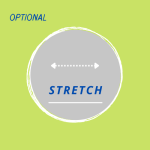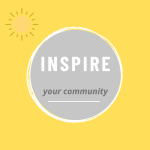Optional: Send Your Letter
Additional Activities
Want to do more? Try some or all of these optional activities.
Stretch: More Writing

Revise with a Publisher in Mind: Figuring out where you’d like to publish your open letter will help in revising it. Come up with three publishing venues for your letter – such as a news site, magazine (print or digital), social-media network, podcast, video channel, or publishing site of your own.
For each venue, jot down a sentence or two to describe their respective audiences. Which audience is the best match for your letter? Here’s your chance to consider who you’re writing for and the best way to convince them. It’s also an opportunity to practice self-compassion, given that some people will never be convinced by the most reasonable arguments.
Test Your Letter: Read your letter out loud to a small group of friends or family. You’ll be able to gauge their response quickly. Do they seem confused? Are they instantly enthusiastic? Ask your test audience what stands out most about the letter or what they care about most. If there’s a consensus, this will help you in pitching it for publication to editors. If your testers all love it – send it.
Use Negative Space – Part 2: What do you need to tell readers and what can remain unsaid? In the writing stretches for the last lesson, I introduced the concept of negative space in the visual arts.[1] What’s unspoken has power, too, as long as the context is clear. In a public open letter, audiences require enough back story to understand your points, but they don’t need your entire life story.
Open letters are most effective when they combine vivid personal stories, a few key facts, and a tight focus. Before you send your letter, cut anything extraneous. Apply the idea of negative space to give what remains more impact.
Respond: More Reading

Read: First-Person Journalism, Chapter 8 (“Convincing Readers”) and Chapter 11 (“Revising for Impact”). Try some of the “Voice Lessons” in these chapters – especially the pitching and tagline exercises in Chapter 11 – adding them to your Process Notebook.
Read/Watch: Ta-Nehisi Coates’s “A Letter to My Son,” an essay excerpted from his 2015 book Between the World and Me.[2] I also highly recommend watching the short Atlantic video, “Creative Breakthroughs: Ta-Nehisi Coates,” in which he talks about his writing process and perseverance.[3]
Respond: Reflect on what you think of the readings or video in your Process Notebook (see suggested prompts in the box below).
Writing Groups: Connecting with Others

Discuss: When meeting with your group (or partner), address the discussion prompts below, especially if you’ve done the suggested readings or watched the video.
Exchange Stories: Share your revised open letters, offering supportive feedback.
Notebook and Discussion Prompts
Respond on your own or discuss with a group:
- Who is the audience for your open letter?
- Where would you like to publish your open letter?
- What worries you most about making your opinion public?
- What can you cut from your current draft – why?
- How might negative space improve your letter’s impact?
- Do you agree with Ta-Nehisi Coates about the writing process?
- Negative space refers to the empty space around an image. Take the illuminated page for your letter: there's space around your imagery as well as the words. Do you think your illuminated page would "pop" with more empty space? Mindfully using negative space is another strategy for highlighting what matters and paring away the rest, as noted by Geoff Livingston in "Writing with Negative Space" (2013) and Camille Cusumano in "Negative Space is a Positive for Creative Writers" (2019), among other writers. As Cusumano puts it, the overfilled mess of social media is "the absence of negative space." Sometimes silence conveys more than words. ↵
- "Letter to My Son" by Ta-Nehisi Coates, Atlantic, July 4, 2015. You can listen to a brief reading by Coates from that essay: "Ta-Nehisi Coates Reads from Between the World and Me." And here's a short PBS Newshour interview with Coates after the book came out in 2015: "Ta-Nehisi Coates: We Accept Violence Against African-Americans as Normal." ↵
- "Creative Breakthroughs: Ta-Nehisi Coates," Atlantic, 2013. ↵